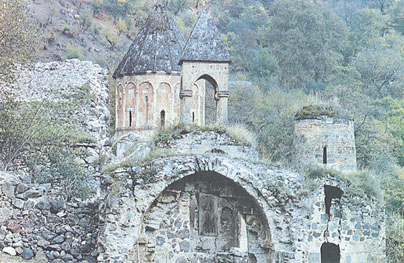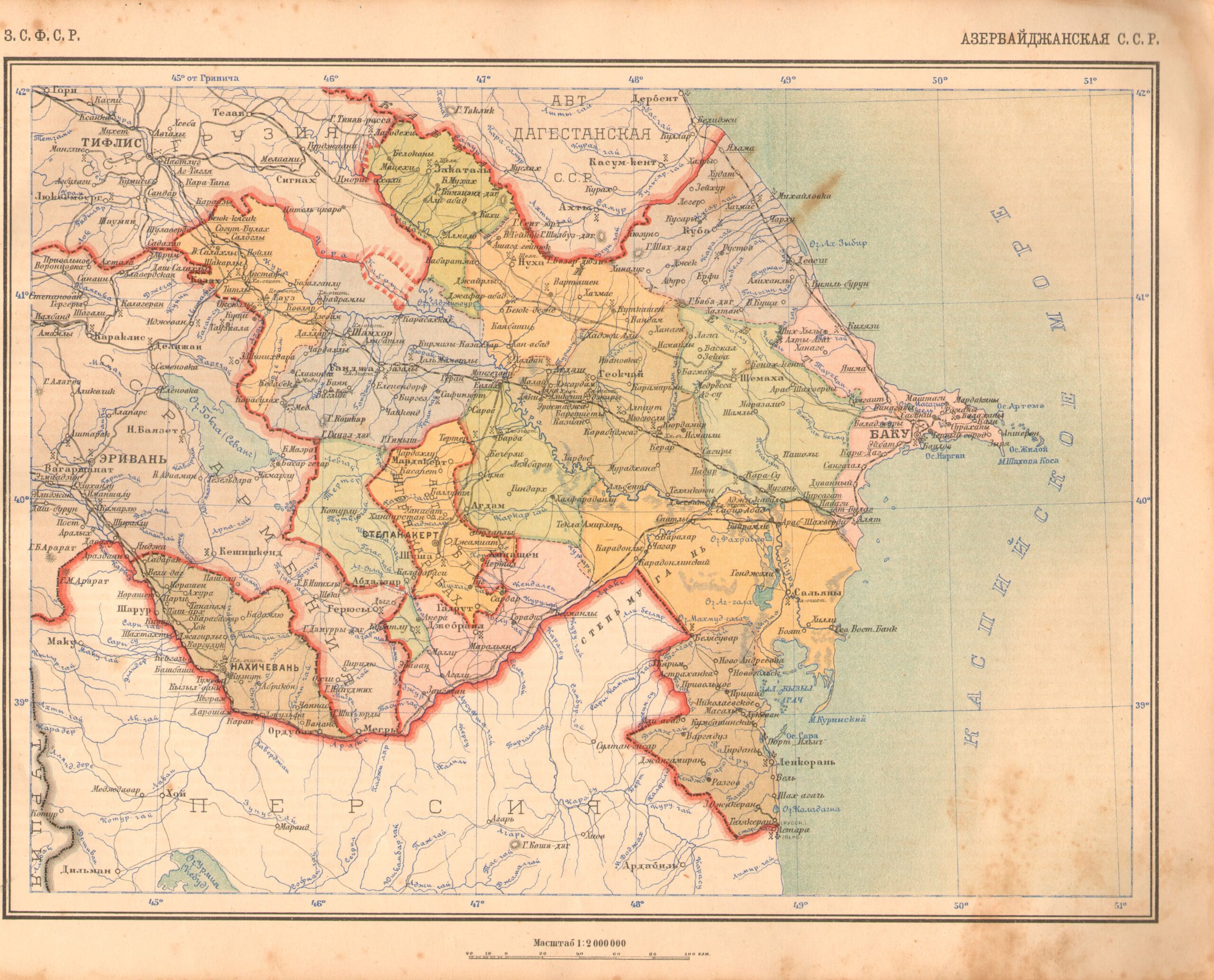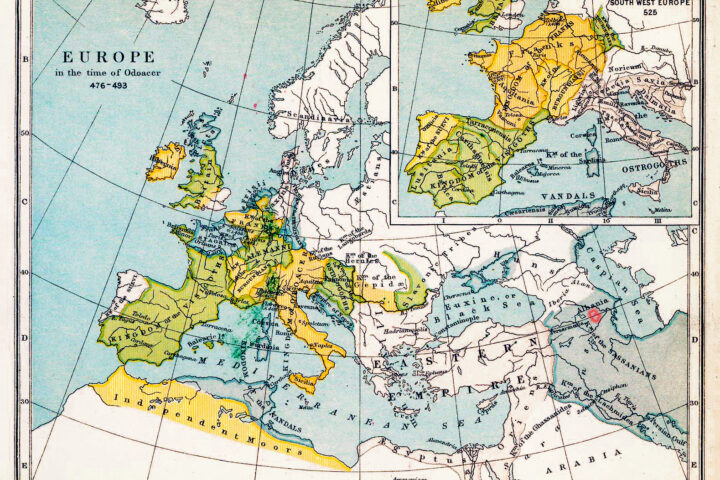Spread of Islam among Albanians and imposition of the authority of the Armenian church over the Christian Albanians, which took place after the Arab invasion became the crucial point in separation of the Albanian ethnicity. As a consequence of further events, Muslim Albanians merged into one Turkophone ethnicity, whereas the Christian Albanians gradually were Armenized, the process, which was completed in the 19th century.
In the 5th-6th centuries, Albania was drawn to the dogmatic struggle of Monophysites and Dyophysites.
At the end of 6th – the beginning of 7th centuries, due to the strengthening of the Byzantine political influence in the Caucasus, the Albanian church together with the Iberian adopted Dyophysitism while the Armenian church preserved its adherence to the Monophysitism.
Beginning from the 40s of 7th century the Karabakh area as well as the whole Albania and the Caucasus underwent invasion of the Arabs professing Islam.
By 705, the Arabs completed the invasion of Albania and the country became to be ruled by the Arab feudal lords – emirs. The Albanian church under the pressure from the Arabs and with the direct assistance of the Armenian church had to renounce Dyophisitism because Arabs couldn’t tolerate the ideological unity of Albania and Byzantium.
In this sect struggle, it’s interesting to point out the role of the Armenian catholicos Yelia who stirred the Arabs up against the Albanian church.
The Armenian catholicos applied to the Arab ruler (khalifa) Abdulmalik requesting to help him to subordinate a number of the Albanian Episcopal districts to his authority. The Albanian historian, the author of «The History of Albania» – one of the most valuable sources on the history of ancient Azerbaijan, which was preserved only in the medieval Armenian translation, gives the text of Yelia’s message to khalifa: «With the God’s almighty will our country obediently submits to your authority. The Aluans [Albanians] profess the same belief to the Christ Son of God, just like we do. But now, the one who is the catholicos of Albania in Partav (Barda), came to an agreement with the Emperor of the Romeans (Byzantines), and praises him in his prayers and forces everyone to unite with him. So know about this, and don’t leave it without attention, because, one noble lady [meaning the princess Sparam, wife of the Albanian prince Varaz Trdat] is together with him. Let’s, with your highest power, punish those, who dared to sin against God»[ref]Moses Kalankaytuk «History of Aghvan» (Albania) book III, chap. V / also: «Sources on the history of Azerbaijan» (Azerbaycan tarixi üzre qaynaqlar) Baku 1989 p. 53 (in Azeri)[/ref].
In reply to this message the khalifa wrote: «I have read [your message] and with compassion, I am sending you my faithful servant with numerous army. I ordered to return the Albanians rebelled against our power to your faith. My servant will punish them in Partav in front of your eyes»[ref]Moses Kalankaytuk «History of Aghvan» (Albania) book III, chap. VI / also: «Sources on the history of Azerbaijan» (Azerbaycan tarixi üzre qaynaqlar) Baku 1989 p. 53 (in Azeri)[/ref].
Yelia with support of the Arab troops arrived in Barda and ruthlessly destroyed those, who aspired to preserve their independence. He also destroyed all the literature in the Albanian language kept in the archives in Barda. He took a written obligation from certain episcopes, particularly from the clergy of the monasteries situated in Karabakh confirming, that they subordinate forever to the Armenian Monophysite catholicity. Yelia also ordered the execution of the last Albanian catholicos Nerses Bakur (686-704).
As a result of these dirty intrigues, the Arabs put an end to Albania’s sovereignty, and the Albanian church was subordinated to the Armenian. This historical event played a crucial role in the gradual process of deethnization and Armenization of a part of the Albanian ethnicity and spread of the epigraphic monuments in the Armenian language in the territory of mountainous Karabakh.
In the same time, with the beginning of the Arab rule, Islam religion began to spread. The population professing local religions (Christianity, fire and idol worshipping) was imposed with a special tax – jizya. Many from the nobility accepted Islam to preserve their power and riches. Some of the poor accepted Islam in order not to pay the tax.
But in certain mountainous regions, particularly in Artsakh which was the religious centre of Christian Albania, Christianity succeeded to preserve its previous positions, albeit fell under the influence of the Armenian church.
This way, the two most important historical events predetermined the future destiny of the Albanian people – the subordination of the Albanian church to the Armenian and conversion of the majority of the Albanian population to Islam. Albanians divided into two parts based on their religious belonging. Consequently, the difference between the customs and traditions caused by different religions deepened this gap further.
On the other hand, since the Albanian church was subordinated to the Armenian church, Christian Albanians willy-nilly had to use the Armenian language – first during the divine services and later in routine life as well.
While the Christian Albanians began to use the Armenian alphabet, the Albanians converted into Islam used the Arabic alphabet. The religious gap gradually led to the cultural and ethnic gap. In the conditions of loss of the political and religious independence, the Christian population of the western regions of Albania began to Grigorianize, particularly in Karabakh where Armenian cultural and political expansion was notably strong.
This resulted in the partial cultural and ideological assimilation and Armenization of the Christian population in these regions. Another part of the Albanians, which accepted Islam together with other Turkic tribes who settled in Albania beginning from the first centuries AD, began to be called under the common name «Muslim».
In Christian regions, the name «Albanian» was preserved and under the influence of the Armenian language was transformed into «Agvan».
In the 7th-9th centuries, due to the increase of the settlement of the Turkic tribes from the North, Albanians were left in the minority and gradually assimilated into one Turkophone ethnicity.
As 8th-9th-century Arab historian Abu Muhammad Abd-al-Malik ibn Hisham informs in his work «Kitab-ul-tidjan fi muluk Himyar» («The book about the rulers of Himyar»), before the campaign to Azerbaijan the Arab caliph Muaviye I (661/180) asked Ubeyda ibn Sheriye what he knew and thought about Azerbaijan. He answered: «That place is a land of the Turks. Having gathered there, they mixed with one another and evolved»[ref]«Sources on the history of Azerbaijan» pp. 56-57 / also: Z. M. Baniatov «Review of the sources on the history of Azerbaijan. Arabic sources» (Obzor istochnikov po istorii Azerbaydzhana. Istochniki arabskiye) Baku 1964 p. 5 (in Russian)[/ref].
Thus, 8th-9th centuries are characterized with the beginning of the shaping of the Azeri people and the Azeri Turk language. This language is mentioned in the 10th-century Arab sources as the «Arran[ian]» language.







